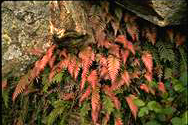Information about plants in flower this week
A news sheet prepared by a Gardens' volunteer.
Numbers before each plant refer to temporary IFTW labels in the gardens.
Numbers in square brackets [ ] refer to garden bed Sections. Plants in flower are in bold type.
View past issues of 'In Flower This Week'.
30 March - 12 April 2016
Doodia aspera fern |
We will take a short walk today from the Visitor Information Centre (VIC) to the waterfall.
- As you leave the VIC notice on your right Epacris impressa [Section 174], or Common Heath, a straggly bush with bright pink tubular flowers. The pink-flowered form seen here is also referred to as Pink Heath, and is the floral emblem of the state of Victoria.
- On your left is Prostanthera phylicifolia [Section 210], or Spiked Mint-bush, which has masses of small mauve flowers on a lax bush which scrambles down a bank. It grows naturally in eastern mainland Australia.
- Cross the bridge and as you go past the café see on your left Doodia aspera [Section 246], a small fern with glorious new pink growth. It is found in the eastern mainland states of Australia. The genus was named for Samuel Doody, curator of the Chelsea Physic Garden.
- Banksia spinulosa 'Coastal Cushion' [Section 131], on your left, has pale yellow cones on a prostrate bush of bright green foliage. It is a coastal form of Banksia spinulosa.
- Banksia spinulosa var. collina [Section 131], also on your left, has fine linear foliage and slender, dull gold cones. This shrub, commonly known as Hill Banksia or Golden Candlesticks, grows along the east coast of Australia in Queensland and New South Wales.
- Turn left up the hill to see on your left a small bush of Correa 'Just a Touch' [Section 124] with dull green foliage and cream bell flowers with just a touch of pink. This cultivar was developed at Bywong Nursery.
- Further on your left is Pavonia hastata [Section 124], commonly known as Spearleaf Swampmallow or Pink Pavonia, with pink "hibiscus" flowers with maroon centres. A native of South America, it has become naturalised in New South Wales, Queensland, Victoria, and South Australia.
- On your left is Correa alba [Section 124], with grey-green leaves and white star flowers. This correa is a popular and reliable plant in the garden. It is native to eastern coastal regions of Australia from northern New South Wales to Tasmania and eastern South Australia.
- On your left is Plectranthus argentatus [Section 110], with textured grey-green leaves and spikes of mauve flowers. It is found in the wild in New South Wales and Queensland.
- Xerochrysum bracteatum [Section 302], or Paper Daisy, is on the right with a mass of bright gold papery flower-heads on green linear foliage. This bright patch is full of butterflies. This plant is widespread in various habitats in all Australian states and territories.
- Callistemon subulatus [Section 110], on your left, has bright red "bottlebrush" flower and a low spreading habit. It is native to New South Wales and Victoria where it grows along the banks of watercourses.
- Callistemon pachyphyllus 'Smoked Salmon' [Section 110] has pink brush-like flowers on stiff foliage. It was developed from a naturally occurring pink-flowered form of C. pachyphyllus found growing in a large stand of the normal red-flowered form in the Runaway Bay area of the Gold Coast. It was brought into cultivation in 1976 by Mrs Joan Barton.
- Bear right towards the waterfall to see on your left Teucrium racemosum [Section 15v], a small delicate bush with narrow silvery leaves and pale blue to white flowers with a prominent lip. It grows in the wild across the mainland Australian states.
- Banksia spinulosa 'Birthday Candles' [Section 15v] is on your left, a dense, bright green bush with needle foliage and short yellow cones with rusty red styles.
- Eremophila christopheri [Section 15v], also on your left, has mauve bell flowers on a small bush with bright green leaves. It is found in the wild in the southern Northern Territory. It is named after Christopher Giles who first collected this species.
Rosalind Walcott
![Director of National Parks [logo]](../../../../images/dnp_90px.gif)







